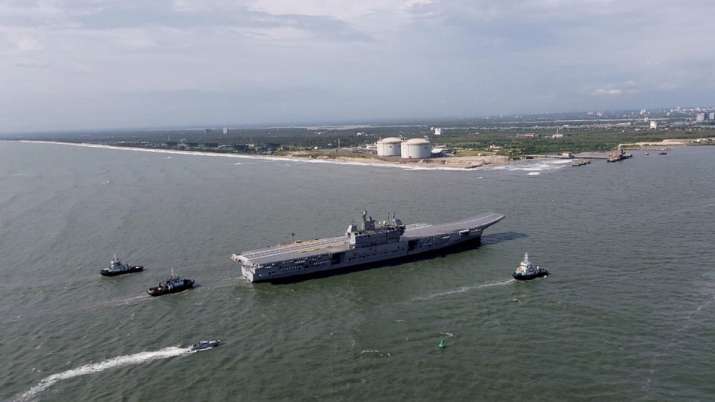
Kochi: Indigenous Aircraft Carrier (IAC) ‘Vikrant’ returns after maiden voyage
As India celebrates its 75th Independence Day on Sunday, the Southern Naval Command (SNC) offered a glimpse of the engineering marvel, the country’s first indigenous Aircraft Carrier (IAC) INS Vikrant. The largest and most complex warship built in the country opened its doors to media persons in Kochi on Friday after successfully completing its maiden sea trials on August 8.
Speaking on the 40,000-tonne warship, Vice Admiral AK Chawla, Flag Officer Commanding-in-Chief, Southern Naval Command said the five-day trial was a “shining testimonial” to the country’s vision of an self-reliant India.
“This demonstrates the Indian Navy’s ability to oversee the construction and construction of the most complex warships, as well as the ability of our shipbuilders and industries to successfully execute such a large and complex shipbuilding project,” he said. is,” he said.
Built at a cost of around Rs 23,000 crore, the IAC has been described by the Navy as “historic” as it has propelled India among the select group of countries with the capability to build a state-of-the-art aircraft carrier.
Commander Sreejith, a senior electrical overseer officer, told PTI that “the power used in the ship could light up half of Kochi city”. However, the official said the electricity generated on the ship could not be disclosed as it was “classified information”.
“All major power industries, including BHEL, have contributed to the construction of this ship. We have used about 2,600 km of cable in it,” he said.
IAC’s designer architect Major Manoj Kumar shared factual details about the aircraft carrier and said, “With the steel used in it, we can build three Eiffel towers”.
“There is a fully functional medical complex with two operation theaters inside the ship. There is a kitchen on the ship to cater for the needs of at least 2,000 employees. We have automated machines in the kitchen. We park 20 aircraft in the hangar. can,” she said.
Anup Hameed, part of the team overseeing the battleship that assesses the ship’s day-to-day progress, said it was a “floating island”.
“The plane needs to generate enough power to take off because of the short runway and we also need a proper mechanism to prevent landing. We need so much power and coordination. Everything is inside this ship. It’s a floating island,” he said.
The power generated in the ship is used for electrical systems including radar systems, communications, navigation, propulsion power generation, steering, air conditioning, food storage, security-related systems, medical systems, he said.
The media team also met women officers who are part of the group that conducted the first sea trials.
“At least 25 women officers from both the Navy and the shipyard are attached to the IAC. Six of them have participated in the sea trials. Two are from the Navy and four are from the CSL,” Lieutenant Commander Janet Maria said. PTI.
Suresh Babu, Advisor to the Chairman and Managing Director, Cochin Shipyard told the media that the sea trials were able to prove the workmanship of CSL.
“We have got two more orders from the Navy, an anti-submarine warship and a next generation missile ship and these are two new orders worth Rs 16,000 crore,” Babu said.
He said that the construction of the IAC was a major challenge for the design team of Cochin Shipyard Limited (CSL). “The design process and construction happened simultaneously. It was very challenging for the designing team,” he said.
He said that at present CSL is the only shipyard in the country which can repair major aircraft carriers. Babu said, “INS Viraat has been overhauled about 13 times here. We have the largest dry dock. We have a 300-member strong designer team and the productivity of CSL helped us in securing orders.”
Navy officials escorted the media team through the hangar and flight deck. Chawla said the country can be justifiably proud of this achievement as India has joined an elite club of nations that can design and build aircraft carriers.
“The Indian Navy is confident that the new Vikrant will carry on the glorious legacy of its predecessor and write a new and glorious chapter in our maritime history,” he said.
The first INS Vikrant played a key role in India’s victory in the Eastern Theater during the 1971 war.
The warship, which will host MiG-29K fighter jets, Kamov-31 helicopters, MH-60R multirole helicopters, has over 2,300 coaches designed for a crew of about 1,700 people, including women officers. Special cabins to accommodate are also included.
The aircraft carrier, with over 76 per cent indigenous components, is expected to induct the Indian Navy by August next year after completing aviation trials.
“Vikrant has a cruising speed of 18 knots with a top speed of about 28 knots and an endurance of about 7,500 knots. The ship can accommodate an assortment of fixed-wing and rotary aircraft,” the Navy said in a statement.
The IAC is 262 meters long, 62 meters wide and has a height of 59 meters. Its construction started in 2009.
Around 550 Indian firms including around 100 MSMEs are registered with Cochin Shipyard Limited (CSL) and they provide various services in manufacturing of IACs.
Read also: INS Vikrant, India’s first indigenously built aircraft carrier, begins sea trials
Read also: Successful test of US aircraft carrier could blunt China’s ‘killer’ missile threat: report
.